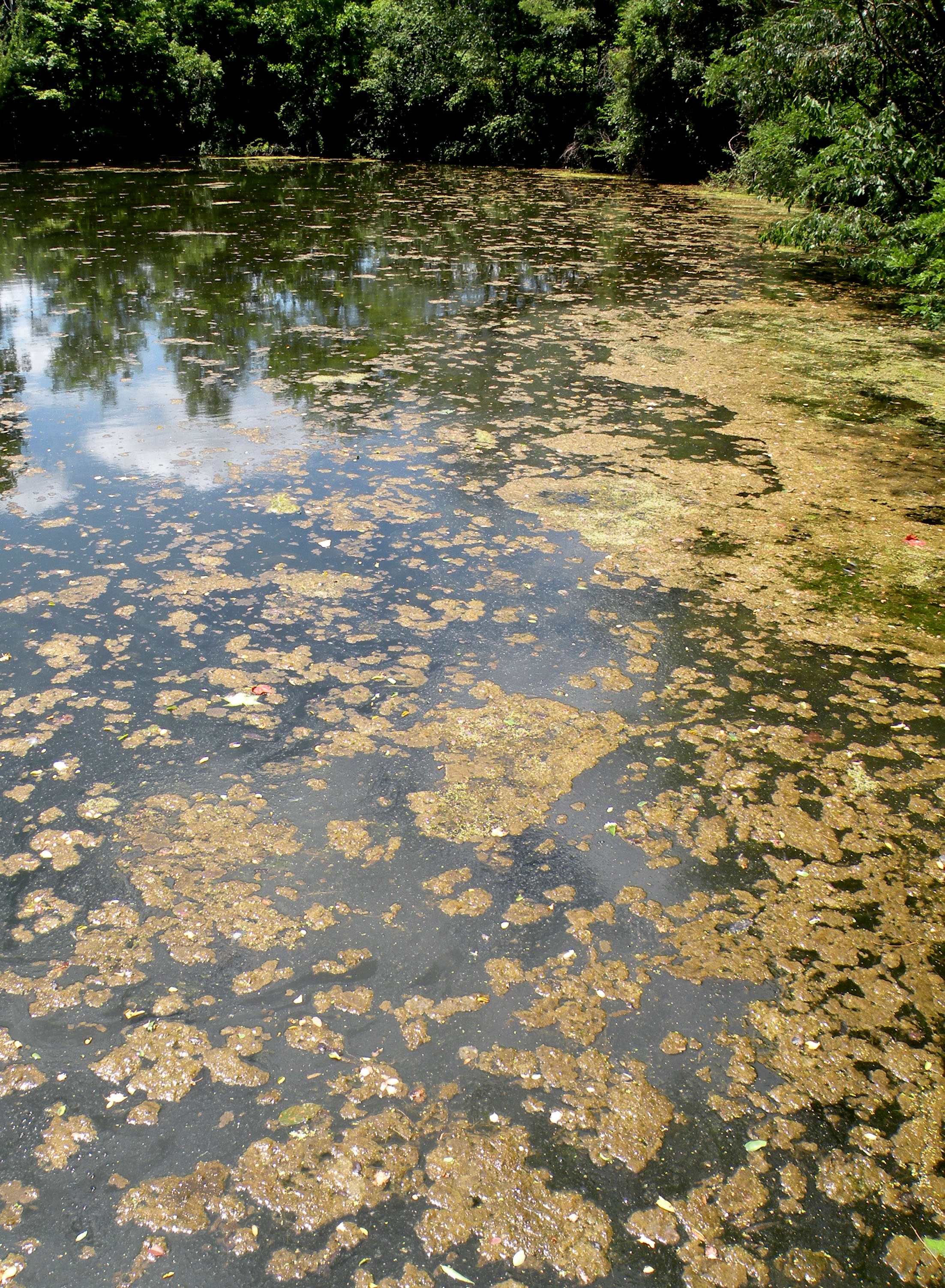Cyanobacteria, once known as blue-green algae, can be found in lakes, rivers, and streams as part of the natural biota. They have similar characteristics as algae and can grow on the water’s surface as a visual bloom or below the water’s surface, attached to submerged materials such as water plants or on the bottom sediment. An over-abundance of these organisms is often called a “bloom”. When the bloom creates undesirable conditions, it may be called a “harmful algal bloom” (HAB) because the organisms can deplete the water of oxygen – killing other aquatic organisms such as fish. Some species of cyanobacteria can produce toxins called cyanotoxins, which can reach levels harmful to human and animal health during harmful algal blooms.
Frequently Asked Questions
What is an algal bloom?
An algal bloom occurs when an alga grows rapidly and abundantly, reaching numbers high enough to be visible to the naked eye often coloring the water and producing a floating scum. Most types of algae can form blooms.
What is a harmful algal bloom (HAB)?
Some algal blooms are harmless and can be natural occurrences within a healthy ecosystem. But some blooms can cause conditions harmful to the health of both humans and the natural environment. HABs can cause widespread fish kills, foul waters or coastlines, and even produce noxious chemicals.
What are cyanobacteria?
Cyanobacteria are single-celled, photosynthetic bacteria that grow in a manner very similar to algae. Once called blue-green algae due to their color and characteristics, these bacteria are found in some of the oldest fossils on Earth and are one of the largest groupings of bacteria. They are found in almost every wet environment on the planet, from the tropics to the poles. Like algae, cyanobacteria are capable of growing to significant size. Some cyanobacteria produce an earthy or musty odor that can make water smell like fresh dirt or a damp basement. And some species of cyanobacteria produce toxins.
What does a cyanobacterial HAB look like?

Some cyanobacteria blooms are easily visible, floating on the surface of water like a mat or foam. They can be blue, green, brown, or even red in color. Other species of cyanobacteria are not as easily visible, as they can be floating in the water below the surface or growing on the bottom of a lake, river, or stream.
What causes a cyanobacterial HAB?
Cyanobacteria typically grow best during the Spring, Summer, and Fall in slow-moving water. They require nutrients such as nitrogen and phosphorus. While these nutrients occur naturally within ecosystems, many water bodies receive excess amounts from human sources. Phosphorus is introduced to waterways by stormwater runoff from farms, towns, and cities. When large amounts of excess nutrients are introduced, cyanobacteria can rapidly grow into a HAB.
What is the Philadelphia Water Department doing to decrease the likelihood of cyanobacterial HABs in our waterways?
PWD actively works with regional partners throughout the Schuylkill and Delaware rivers’ watersheds to implement stormwater control practices and nutrient management strategies. By limiting the amount of excess nutrients entering our waterways, cyanobacteria are deprived of the essential components they rely upon to bloom.
What are the dangers of a cyanobacterial HAB?
First, they can be a nuisance as they make a water unsuitable for recreation and can produce undesirable odors. Second, they can deplete the oxygen in water and make other changes that affect the aquatic life, even causing fish kills. More importantly, they can sometimes produce toxins that can affect animals and people who recreate in the water or drink the water. Often this is experienced as allergic-type symptoms but cyanotoxins have been known to kill cattle and horses.
Do all cyanobacteria produce toxins?
No, there are thousands of species of cyanobacteria and not all produce cyanotoxins. Even those that can produce toxins do not do so consistently or predictably.
How can you or your pets be exposed to HABs and toxins?
Swimming or taking part in other recreational activities within a water body that is experiencing a cyanobacterial HAB can lead to exposure through the skin, eyes, ears, and nose. Animals can carry the toxin back out of the water on their fur or hair, thus exposing their owners. Aerosols of the water can lead to inhalation risks.
What types of illnesses can exposure to a cyanobacterial HAB cause?
Depending on the toxin and concentration consumed, an individual who has ingested cyanotoxins may experience gastroenteritis, liver or kidney damage, or negative neurotoxic effects. Exposure to elevated levels of cyanotoxins via the skin can also cause eye, ear, or skin irritation.
How are cyanobacteria and cyanotoxins detected?
Cyanotoxins are colorless, odorless, and tasteless. They can only be reliably detected in an appropriately equipped lab. Scientists and lab technicians can use probes to detect the presence of cyanobacteria pigments, microscopes to monitor for cyanobacteria cells, and specialized equipment to detect the presence of toxin-producing genes.
Does the Philadelphia Water Department monitor for cyanotoxins?
Yes, PWD began sampling river water for cyanobacterial toxins in 2012. The most commonly occurring cyanotoxin – a class of compounds called microcystin – has only been found in a small fraction of tested river water samples and has never been found at concentrations exceeding the EPA’s health advisory levels set by the EPA for drinking water. PWD also has a long history of monitoring the two rivers for algae, including cyanobacteria.
How can I reduce the occurrence of HABs?
Use only the recommended amounts of fertilizer and other lawn treatment chemicals. Follow best management practices for minimizing stormwater runoff – especially from farms and nearby livestock – to limit the nutrients available to cyanobacteria.
Where can I find more information?
The EPA details a wealth of information about cyanobacteria and HABs – including health and ecological impacts, control and treatment strategies, and state resources: